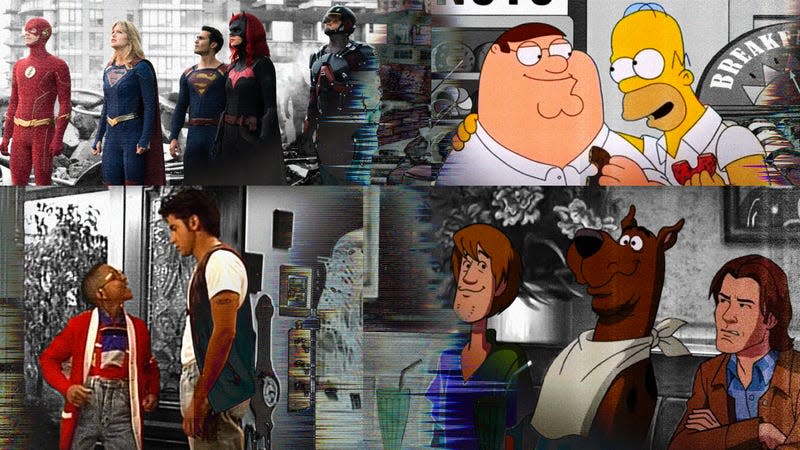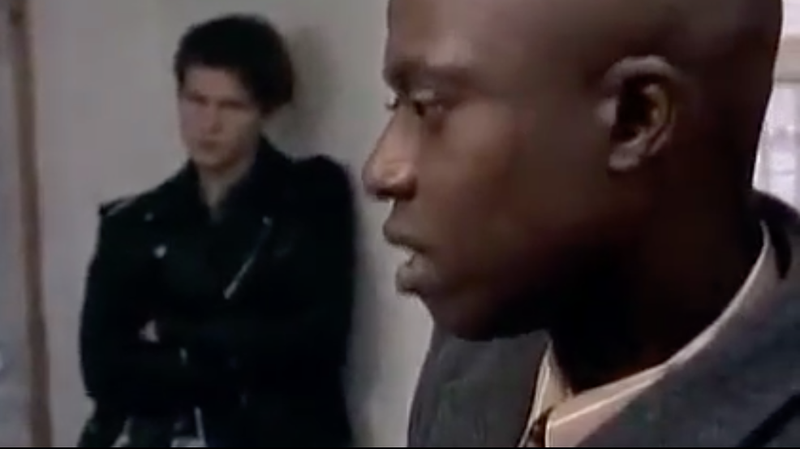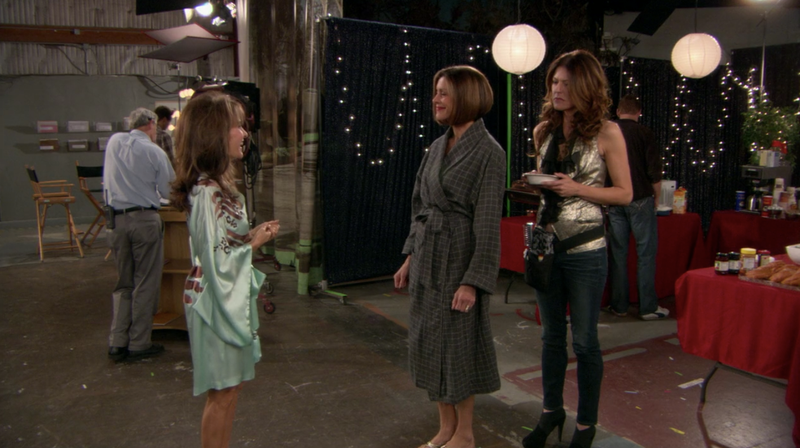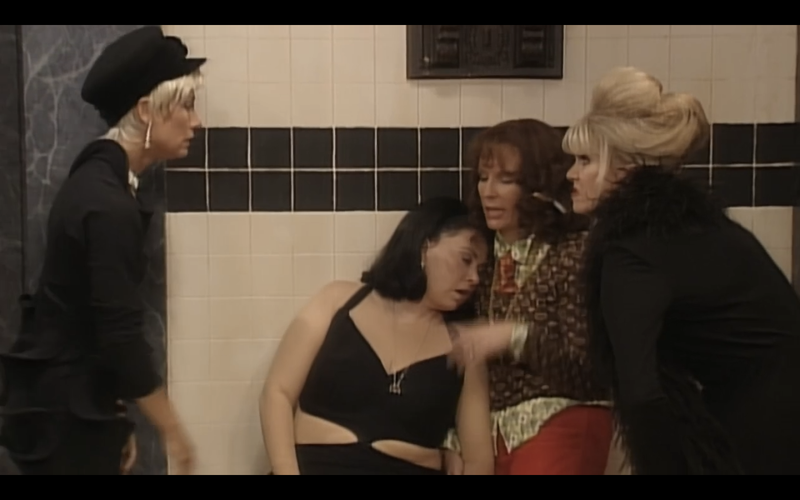When Urkel met Tanner: 16 unexpected TV crossover episodes

- Oops!Something went wrong.Please try again later.
- Oops!Something went wrong.Please try again later.
Around the release of 2018’s Avengers: Infinity War, social media was inundated with challengers to the Marvel film’s throne as the “most ambitious crossover event in history.” These suggestions were, as tweets and Instagram memes tend to be, largely facetious, but credit where it’s due: It does take a certain creative ingenuity and gumption to, say, tie together the Disney Channel’s assorted mid-’00s multi-camera sitcoms in a single TV movie—one that harkens back to the time when, 30 years ago this week, TGIF worlds collided as Steve Urkel took a cross-country trek and popped up in the Tanner family’s living room. TV has a long history of connecting its fictional universes in various ways that could be described as ambitious (or, if you’re feeling less charitable, desperate for cross-promotion). Whether it’s the sheer number of shows involved in Crisis On Infinite Earths, a plot device (like a hurricane, say) introduced to unite a seemingly random lineup, or the bridging of disparate styles (Cops and The X-Files), genres (St. Elsewhereand Cheers), time periods (The Fresh Prince and The Jeffersons), geographic locations (Roseanne and AbFab), or media (Supernatural and Scooby-Doo), sometimes bringing disparate shows together results in effective episodic alchemy. Here are 16 TV episodes that stretched the limits of what the crossover could accomplish.
1. Charlie’s Angels/The Love Boat, “Love Boat Angels” (1979)
For a show that was only around for five seasons, Charlie’s Angels had a lot of cast changes, with six Angels eventually inhabiting the three title roles. To kick off Shelley Hack’s short tenure as Tiffany Welles for the fourth season, producer Aaron Spelling married two of his most popular properties for a two-part episode. In “Love Boat Angels,” Kris (Cheryl Ladd), Kelly (Jaclyn Smith), and Tiffany head off on the Pacific Princess trailing art thieves Bert Convy and Bo Hopkins. “Love Boat Angels” pulls off what only the best crossover episodes can: It brings two previously unconnected shows together, placing familiar characters in alien yet still familiar settings—like the Lido Deck. In doing so, it brings out the best in both series: a romantic To Catch A Thief vibe for Angels, as Kris falls for one of the art smugglers, and the tropical escapism of Love Boat, as the Angels gang hits the idyllic white beaches of the Caribbean, culminating in an inevitable scuba-diving showdown. [Gwen Ihnat]
2. Family Guy/The Simpsons, “The Simpsons Guy” (2014)
Let’s be very clear: This is an episode of Family Guy, not The Simpsons. That much is obvious even if the opening plot contrivance—Peter Griffin takes his family on the run to escape the outcry over a misogynistic comic he drew—wasn’t enough to tip viewers off as to who was in charge. It’s there in the cringe-inducing montage of Peter and Homer hosting a wet T-shirt car wash (Get it? The joke is that they’re fat guys, not lithe young women!). It’s there in the lazy narrative construction (“Hey, those chicken fights are popular! Let’s do that, but with Homer!”). And boy, oh boy, is it ever there in the way that Family Guy’s sensibility steamrolls over the very concept of Simpsons-like comedy. As with any episode of the series, there’s good mixed in with the bad, but the landmark nature of a crossover like this should’ve afforded a more intriguing setup. The ambition is clear, from the aforementioned fight between Peter and Homer to the ways each universe keeps trying to integrate aspects of the other. Unfortunately, the aspirational hopes of one of the 21st century’s biggest animated sitcoms tackling a union with maybe the greatest sitcom of all time doesn’t land in Family Guy’s favor. Not that anyone didn’t see that coming. [Alex McLevy]
3. Law & Order/Homicide: Life On The Street, “Charm City”/“For God And Country” (1996)

Homicide: Life On The Street and Law & Order actually teamed up on three different occasions: in 1996, 1997, and 1999. But we’re singling out “Charm City” and “For God And Country” for kicking things off and bridging the divide between Paul Attanasio’s searing NBC series (which was based on David Simon’s Homicide: A Year On The Killing Streets) and Dick Wolf’s ever-expanding franchise. The episodes, written by Wolf, Michael S. Chernuchin, and Jorge Zamacona, established an M.O. we’d see in future Homicide/L&O crossovers, as well as crossovers between Law & Order and its spin-offs (and ultimately, between Law & Order: Special Victims Unit and Wolf’s Chicago shows, below). A harrowing tale from from start to finish, from New York to Baltimore, “Charm City” opens with the NYPD’s investigation of a subway bombing that killed 20 people. Soon, Baltimore detectives Frank Pembleton (Andre Braugher) and Tim Bayliss (Kyle Secor) have linked the attack to a church bombing in their own city five years prior. Their joint narrative provided an unflinching look at the ties between white supremacy and violence, and a frisson of justice in the verdict rendered in “For God And Country.” [Danette Chavez]
4. Full House/Family Matters, “Stephanie Gets Framed” (1991)
Like Happy Days before it, Family Matters seemed to both explode and implode after a recurring character—Fonzie in the former case, Steve Urkel in the latter—stole the spotlight from the original cast. It’s no surprise, then, that the poor Winslow clan is nowhere to be found in the show’s TGI-eriffic crossover with Full House. Nope, it’s Jaleel White’s Urkel who headlines “Stephanie Gets Framed,” a fourth-season episode in which the cheese-loving dweeb—a cousin of D.J.’s pal, Julie—recounts his own birth, trades walking tips with Uncle Jesse (John Stamos), and helps a vision-impaired Stephanie (Jodie Sweetin) cope with having to wear a pair of coke-bottle glasses. Unfortunately, we have to call bullshit on his advice; if he believes his glasses make him look “studlier,” then why doesn’t Stefan Urquelle, the “cool” version of Steve introduced in Family Matters’ fourth season, wear them? We don’t buy it, Steve, and his advice to “make the bullies laugh with you, not at you” only ends up getting Stephanie in trouble. In the end, it’s Uncle Joey (Dave Coulier), not Urkel, who helps her embrace her new pair of specs. Never trust someone who talks like Mickey Mouse. [Randall Colburn]
5. The CW superhero shows, Crisis On Infinite Earths (2019-2020)
Crossovers were nothing new for The CW’s superhero shows when Crisis On Infinite Earths came along, since the characters from Arrow and The Flash had already been holding annual meet-ups for years at that point. It was bigger than every previous crossover, certainly, since it ran for five hours and encompassed five separate shows—Supergirl, DC’s Legends Of Tomorrow, and Batwoman in addition to Arrow and The Flash—but what made it truly ambitious was that Arrowverse producer and Crisis mastermind Marc Guggenheim didn’t stop there. In addition to connecting to those five shows, Crisis was also a crossover with The CW’s Black Lightning, Fox’s Lucifer, the ’90s Flash series, the 2002 Birds Of Prey series, Smallville, Superman Returns, Batman: The Animated Series (via a live-action appearance from voice actor Kevin Conroy), Tim Burton’s Batman movie (with a cameo from Robert Wuhl), the Stargirl show that hadn’t even aired yet, DC Universe’s Titans, the ’60s Batman show (with an appearance from Burt Ward), and even the DC movie universe. In fact, as wild as it is, it’s now canon that Ezra Miller’s Justice League Flash got his superhero name from meeting Grant Gustin’s TV Flash. [Sam Barsanti]
6. Supernatural/Scooby-Doo, “Scoobynatural” (2018)
It’s one thing to have two animated series do a crossover episode; it’s quite another to transform a live-action series into the cartoon version of itself for a meetup with some animated predecessors. Yet the way that Supernatural zapped its heroes into two-dimensional iterations of themselves for a mashup with the Scooby-Doo gang, while still maintaining the qualities that make both shows unique, was impressive even without the digital transmogrification. Fred, Velma, Daphne, Shaggy, and Scooby are all the charmingly recognizable characters we know from childhood, and when Sam (Jared Padalecki) and Dean Winchester (Jensen Ackles), along with angel Castiel (Misha Collins), get beamed into Dean’s beloved cartoon show from his youth, his response is as enthusiastic as you might expect. It makes sense: As we said in our review at the time, “Going to scary places, solving mysteries, fighting ghosts… that’s what both of them do.” But only Supernatural is actually set in a world where demons and monsters are real, and the episode ends up being about how the brothers decide to keep the Mystery Mobile gang innocent of the knowledge that the supernatural really exists. In the process, they tone down their usual darkness to play along with the sweet sentiments of the animated classic; the result is a superlative installment of both shows. [Alex McLevy]
7. The Jetsons/The Flintstones, The Jetsons Meet The Flintstones (1987)
It’s a little shocking, frankly, that it took 25 years for Hanna-Barbera’s two flagship animated families to meet. Sure, George Jetson and Fred Flintstone (and their respective broods) exist some not-especially-well-defined number of millennia from each other, but the Flintstones and the Jetsons have always been united by a single powerful theme: That no stock sitcom plot could ever be so tired that it couldn’t be recycled for a Saturday morning cartoon about grouchy caveman or hapless space dweebs. This premise finally came to fruition with 1987’s aptly titled The Jetsons Meet The Flintstones, where the two families not only befriend each other but also engage in a little life-swapping: Fred becomes a futuristic car executive (obviously) while living it up in Jetson times, while George ends up using his futuristic celebrity to buy up large chunks of Bedrock, fulfilling mankind’s long-brewing dream to gentrify the past. [William Hughes]
8. ALF/Gilligan’s Island, “Somewhere Over The Rerun” (1987)
ALF had a lot of nerve criticizing Gilligan’s Island for being formulaic, given that the chaotic changes wrought by their alien houseguest rarely stuck to the Tanner family over the course of the sitcom’s four-season run. (To be fair, there was the birth of a new baby and the death of the family cat. But ALF wasn’t responsible for either of those—that we know of.) Some might argue that’s the point of the season-two crossover episode “Somewhere Over The Rerun,” in which ALF learns a Wizard Of Oz-style lesson in appreciating what he has by experiencing a tedious day in the life of the now-middle-aged castaways on his favorite sitcom. (Turns out when all you have is coconuts and sand, meatloaf and hot baths sound positively blissful by comparison.) Despite his professed worship of Gilligan, Mary Ann, and the gang, however, ALF—like everyone else who visits the island—leaves them behind to rot at the end of the episode. For that, you can thank another hoary old sitcom device: Turns out it was all a dream. [Katie Rife]
9. Golden Girls/Empty Nest/Nurses, “Hurricane Saturday” (1991)
Before Shonda Rhimes instituted TGIT, TV veteran Susan Harris set up a “Hurricane Saturday” for her three interconnected NBC sitcoms: Golden Girls, which begat Empty Nest, which begat Nurses. The two-hour programming block was a one-time affair that kicked off with the Girls’ “Monkey Show,” an uproariously tense, yet poignant episode that saw Dorothy (Bea Arthur) and Sophia (Estelle Getty) at loggerheads once more in the midst of the eponymous storm. Their family strife led into Empty Nest’s “Windy,” where the hurricane stirs up plenty of memories for the widowed Dr. Harry Weston (Richard Mulligan) and his daughters, Carol (Dinah Manoff) and Barbara (Kristy McNichol), as they pack up their old house. The fledgling Nurses, which followed the staff at the Miami hospital where Harry Weston worked, closed out the programming block with “Begone With The Wind.” Despite the (fictional) hazardous conditions, characters move with ease between shows and stories; Sophia warns the Westons of the impending storm, Rose shirks her telethon duties to help out the nurses on Nurses. But it’s Carol who gets the biggest laugh, as she reveals that her psychiatrist boyfriend’s idea of pillow talk is gabbing about Dorothy (Morothy) and her ex-husband/sometimes suitor Stan (sorry, Dan). [Danette Chavez]
10. St. Elsewhere/Cheers, “Cheers” (1985)
As a pregnant Carla Tortelli (Rhea Perlman) is carried out of Cheers in the direction of the delivery room, she calls out to her customers for a “last shot at a pity tip”: “Mail it to me—I’ll be at St. Eligius Hospital.” That destination was the official name of the dumpy facility at the center of St. Elsewhere, the inventive medical drama that premiered during the same fall on the same network as Cheers, and even took place in the same city. Fast forward one year, and Boston’s surliest barmaid faced down the St. Eligius staff once more—on her home turf, but in an episode of their show. In what Cheers writer-producer Ken Levine once called “maybe the strangest cross-promotion in television history,” St. Elsewhere’s third-season finale sends Drs. Donald Westphall (Ed Flanders), Daniel Auschlander (Norman Lloyd), and Mark Craig (William Daniels) to Sam Malone’s place for cocktails, commiseration, and a catch-up with Auschlander’s former accountant, Norm Peterson (George Wendt). It was an opportunity to pit two of NBC’s reigning insult artists—Carla and Craig—against each other, but as strange as it is to hear Perlman deliver those lines without the feedback of a live studio audience, it’s no more bizarre than any of the other times St. Elsewhere served as a gateway between fictional worlds, a tendency toward meta-commentary that made it the inflection point in the mother of all TV crossover theories. [Erik Adams]
11. Archer/Bob’s Burgers, “Fugue And Riffs” (2013)
It’s hard to overstate the immense tonal difference between Fox’s perennial family-forward hit Bob’s Burgers and FX’s much more adult comedy Archer. One centers on a largely straitlaced restaurant owner with a strong work ethic and an abiding love for his family; the other focuses on Sterling Archer, a boozehound of a spy with a healthy appetite for danger and a strong aversion to hard work. But both soar thanks, in part, to H. Jon Benjamin in both title roles, as he manages to minutely adjust his often (hilariously) flat delivery to fit any personality. Still, it was a total trip to witness the Belcher family undergo a brief makeover and enter the sleek universe of Archer’s fourth-season premiere, where “Bob” is actually a mustachioed Sterling navigating a lengthy amnestic episode. Much like the Bob we know, Archer is perpetually stressed and simultaneously in love with and exhausted by his family (which, in this case, is only a two-month-old development). But no matter how many adventures we’ve traversed alongside the Belcher family over the past decade, there’s no getting used to the image of a blood-splattered Bob taking down the KGB just before he unflinchingly leaves Linda, Tina, Gene, and Louise behind. The moment was an entertaining mind melt for fans of both comedies, and a nice reminder of Benjamin’s enduring legacy in prime-time animation. [Shannon Miller]
12. The Fresh Prince Of Bel-Air/The Jeffersons, “Will Is From Mars…” (1995)
The Fresh Prince Of Bel-Air was also the king of sitcom crossovers, as cast members lent their star power to series like Blossom—which hosted multiple Fresh Prince cameos when the two aired back-to-back on NBC—and In The House, which was canceled after two seasons despite appearances from both Carlton and Ashley. The very-special-guest-star street went the other way, too, as the show gave a nod to its Black sitcom forebears The Jeffersons on the season-five episode “Will Is From Mars…” The basic premise of the episode is that Will (Will Smith) and his fiancée, Lisa (Nia Long), go to couples’ therapy at the request of Uncle Phil (James Avery), who may have ulterior motives (okay, he definitely does). The scheme almost works, as the therapy backfires, and Will and Lisa’s relationship is nearly destroyed by their incompetent counselor. What these two need is some real talk from a long-term couple that’s been there—like George and Weezie (Sherman Hemsley and Isabel Sanford), who teach the younger couple their love language of barbed insults and fierce loyalty during a group therapy session that turns into an out-and-out brawl. The Jeffersons would later return for the series finale, this time accompanied by Diff’rent Strokes’ Arnold and Mr. Drummond. We told you the Banks were sociable. [Katie Rife]
13. Hot In Cleveland/All My Children/Jimmy Kimmel Live!, “I Love Lucci, Parts 1 and 2” (2011)

Hot In Cleveland’s four hot Cleveland ladies head to glamorous L.A. for this season two two-parter. Victoria (Wendie Malick) has a guest spot on All My Children, which only enflames her long-time rivalry with that “second-rate little sock puppet,” diminutive soap queen Susan Lucci. Meanwhile AMC’s Michael E. Knight utilizes the caddish characteristics of his daytime drama character, Tad, to woo Joy (Jane Leeves). The always game Lucci and Malick’s Victoria trade one delightfully bitchy barb after another (she would appear on six episodes of HIC in total). Meanwhile, Elka (Betty White) crashes Jimmy Kimmel Live! in an attempt to meet Robert Redford, naturally winding up on the show in the process. Even Melanie’s (Valerie Bertinelli) side plot featured sitcom heavyweights Max Greenfield and Leslie Grossman as an L.A. power couple. The underrated TV Land sitcom took full advantage of all that guest star momentum, letting the visiting players camp it up to the hilt, while highlighting the funniest qualities of HIC’s main characters. [Gwen Ihnat]
14. Dick Wolf’s One Chicago/Law & Order: Special Victims Unit, various (2014)
When Dick Wolf set up shop in Chicago at Cinespace Film Studios, he did so with every intention of having regular crossovers. Chicago Fire sparked Chicago P.D., which gave birth to Chicago Med (Chicago Justice’s New York ties ultimately cost it a second season of Second City-based stories), and all the various first responders work together just as they do in real life. (At least, according to Wolf’s rose-tinted view of Chicago emergency services.) And because Wolf and his frequent collaborator Warren Leight can’t help themselves, there have also been a few crossovers with Law & Order: Special Victims Unit (now the longest-running primetime live-action procedural). The inaugural SVU/Chicago crossover spanned two nights in 2014, beginning with Chicago Fire’s “Nobody Touches Anything,” which gave way to SVU’s “Chicago Crossover,” and concluded with Chicago P.D.’s “They’ll Have To Go Through Me,” as Chicago cops Voight (Jason Beghe), Lindsay (Sophia Bush), and Halstead (Jesse Lee Soffer) end up on Detective Benson’s (Mariska Hargitay) turf when they track a child victim of sexual abuse images to New York City. The Chicago shows (collectively/colloquially known as One Chicago) helped Wolf take over NBC’s Wednesday night lineup, buoyed by ratings. Wolf’s crossovers have even made room for his FBI series, which airs on CBS. [Danette Chavez]
15. TheX-Files/Cops, “X-Cops” (2000)
One of the sci-fi series’ funniest episodes is also one of its most innovative. A crossover of two unlikely properties, “X-Cops” works primarily due to the lengths Vince Gilligan and his team went to to ensure the episode felt more like Cops than The X-Files. It begins with the Cops theme, utilizes Cops’ bumper shots, and rounds out the cast and crew with actual officers and alums of the reality series. It works, too. After Mulder and Scully intersect with the cops (and their film crew), all of whom are investigating reports of a “monster,” the presence of in-world cameras casts our heroes in an entirely new light, with Mulder relishing the spotlight and Scully resisting it (unsurprising on both counts). Many of the tricks used in found-footage horror—long, unbroken shots, improvisatory dialogue, obfuscated scares—are found here, adding a new and welcome texture to the series’ monster-of-the-week format. Not everyone loves The X-Files’ gimmicky episodes, but “X-Cops” is easily one of the best. [Randall Colburn]
16. Roseanne/Absolutely Fabulous, “Satan, Darling” (1996)

While Roseanne Barr has thankfully retreated into obscurity, it’s hard to deny the effect of her eponymous sitcom during its initial nine seasons. The series was praised for its depiction of a lower-middle-class family, and the Conners were one of the last TV clans you’d expect to cross paths with the high-society-adjacent Edina Monsoon (Jennifer Saunders) and Patsy Stone (Joanna Lumley) of Absolutely Fabulous. But that all changed when Barr had Roseanne win the lottery. The plot development was widely criticized (and completely invalidated at the end of season nine), but at least it gave us the chance to watch Roseanne get wasted with the AbFab ladies. Barr had purchased the rights to the beloved British comedy, with intentions of adapting it for American television, and asked Saunders to help her craft a story that would fuse the two worlds. The result was the season-nine Halloween episode, which starts with Roseanne and her sister, Jackie (Laurie Metcalf, still doing great work on The Conners), at a charity gala in New York City and devolves into a Rosemary’s Baby fever dream featuring That Girl’s Marlo Thomas. In 2018, Saunders told Graham Norton about her Roseanne experience: “We were quite confused. But it was fun.” That about sums up the viewing experience, too. [Patrick Gomez]

